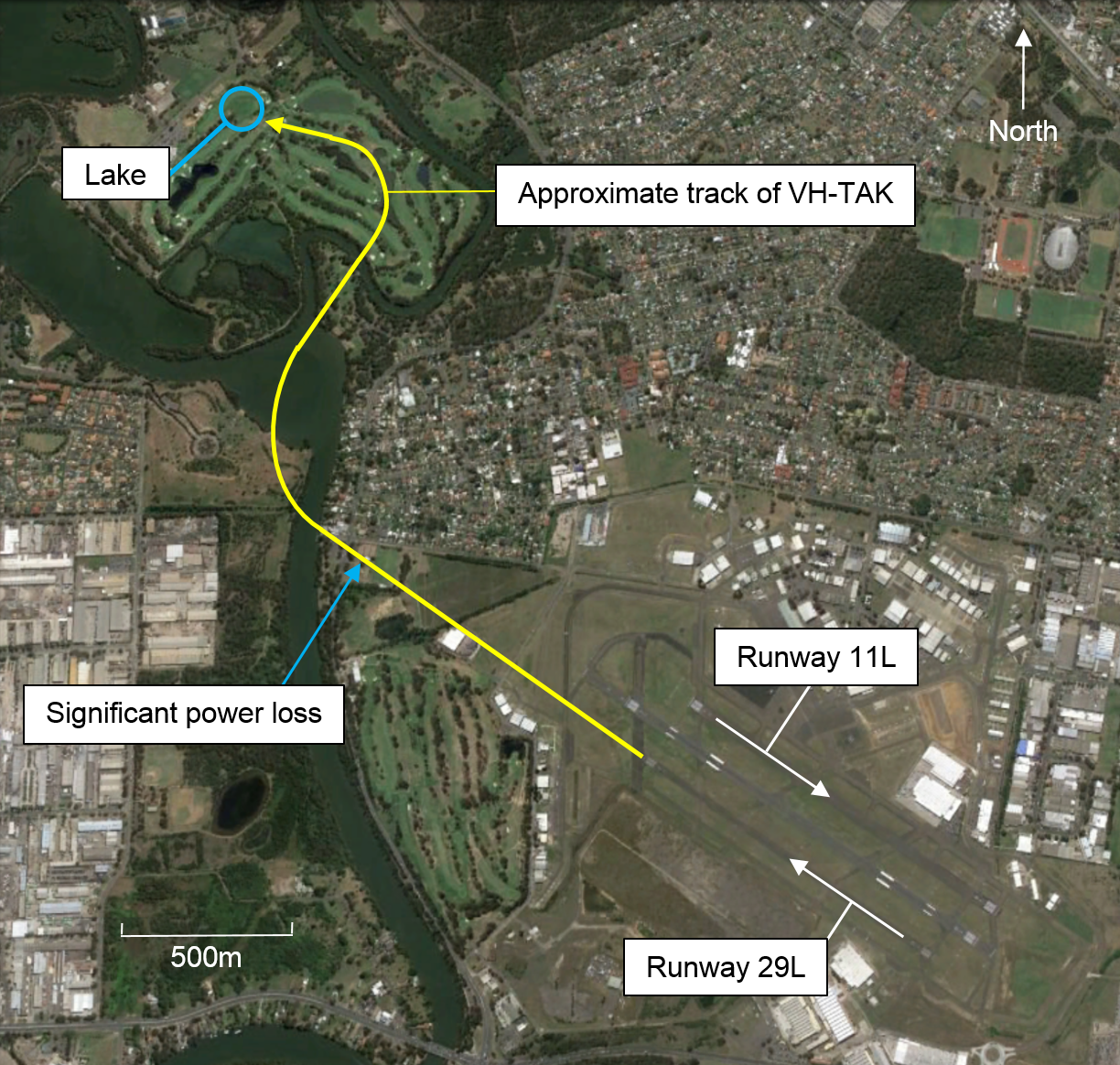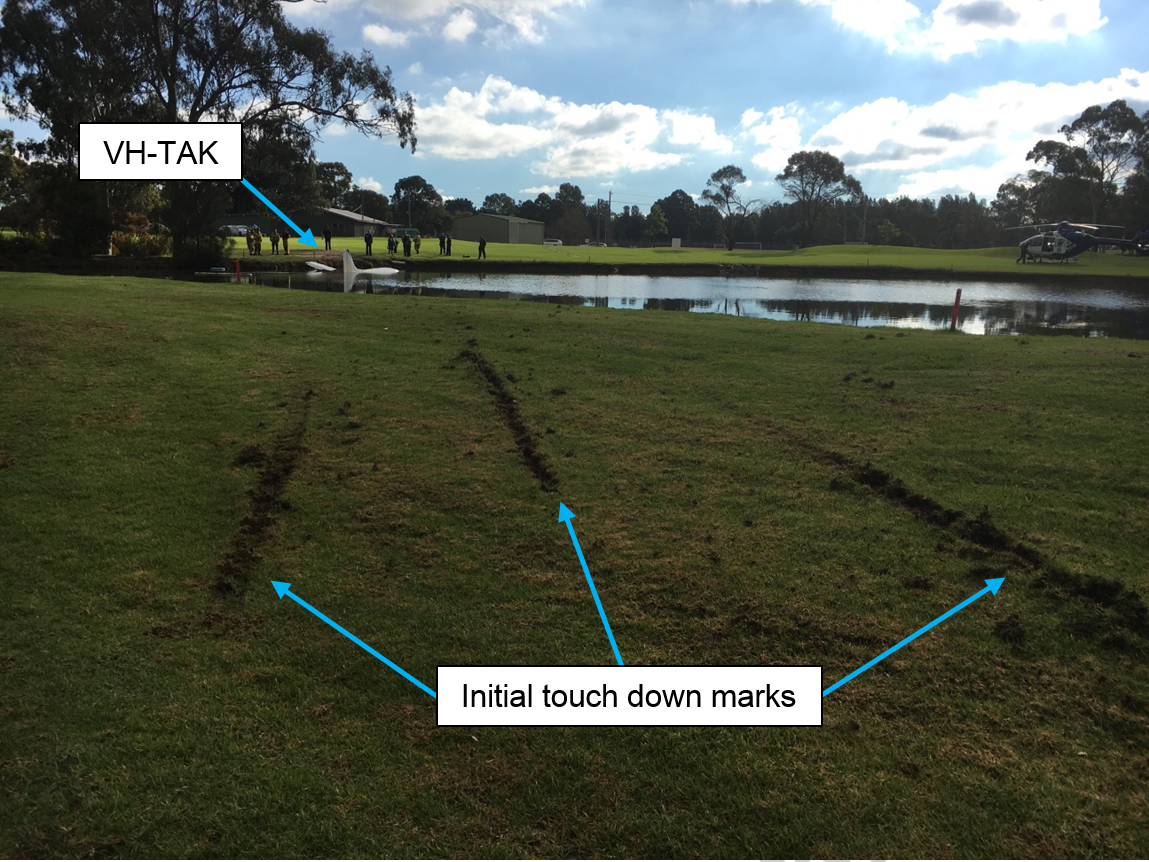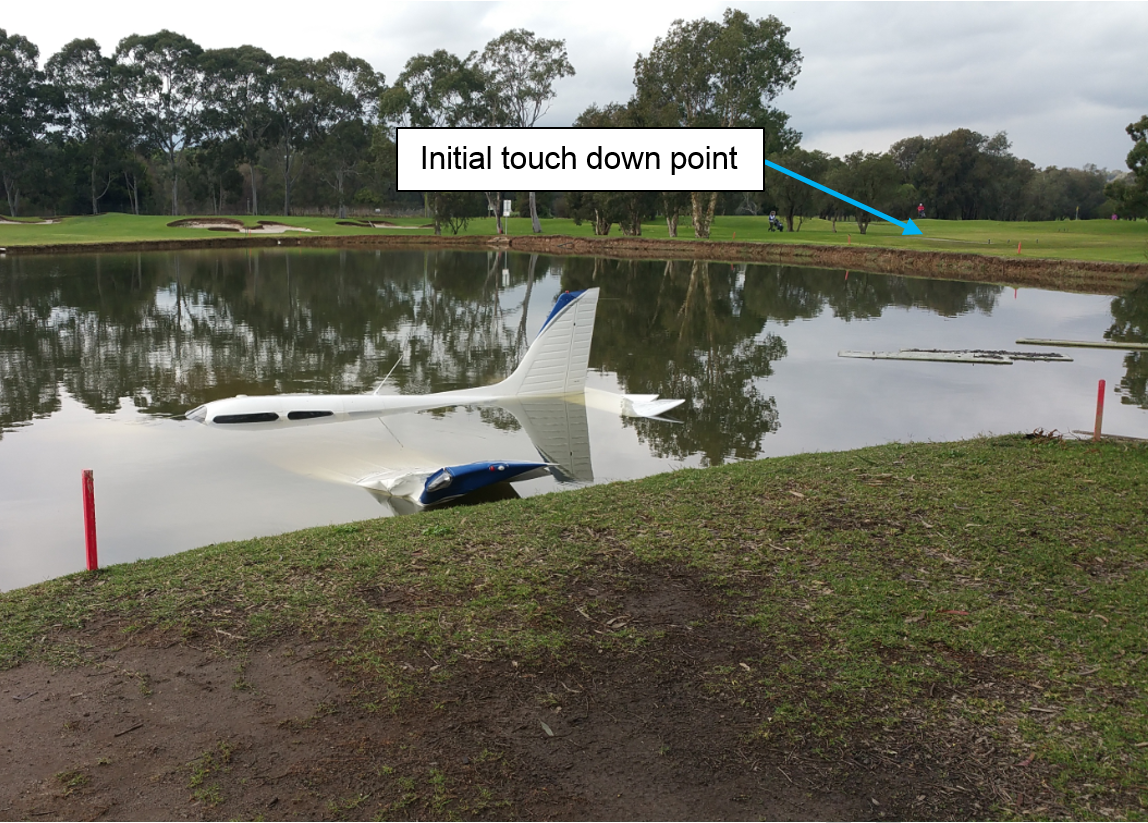What happened
At about 1344 Eastern Standard Time (EST), on 21 July 2016, a Piper PA-28-161 aircraft, registered VH-TAK (TAK), departed from runway 29 Left (29L) at Bankstown Airport, New South Wales, for a post-maintenance test flight. On board the aircraft were a pilot, an engineer from the maintenance provider and a passenger.
As the aircraft climbed through about 300 ft above ground level (AGL), the pilot observed a slight loss of power produced by the engine. The pilot reported that at that time, the engine continued to run smoothly and TAK continued to climb. At a height of about 400 ft, the power loss increased (Figure 1), the engine was then producing about 1600 RPM[1] and the pilot reported that the engine was ‘chugging’. The pilot made a right turn to attempt to return to Bankstown Airport to land on runway 11 Left (11L). The pilot broadcast a PAN[2] call and established TAK on a base leg for runway 11L.
Figure 1: Overview of accident flight

Source: Google earth, modified by ATSB
Once established on the base leg for runway 11L at an altitude of about 200 ft, the pilot assessed that the engine was not producing sufficient power to fly to runway 11L. At that time, the engine was vibrating considerably. The carburettor heat was then selected on, without effect. The pilot commented that they did not have sufficient time to change fuel tanks. The pilot observed a clear area within a golf course to the left of the aircraft and manoeuvred to land in that area. Due to the close proximity of the clear area, the pilot immediately reduced the power to idle and selected full flap.
TAK landed on the up slope of a mound at the edge of a small lake and bounced back into the air (Figure 2). The pilot then attempted to fly the aircraft over the lake, but soon assessed that it did not have sufficient speed or height to clear the lake, and directed the occupants to brace for impact. TAK landed in the lake on the main wheels. The nose of the aircraft struck the water and submerged momentarily, before returning to the surface. After the aircraft stopped, the occupants immediately exited the aircraft through the door on the right side. They climbed over the fuselage and along the left wing to the edge of the lake (Figure 3). The pilot and occupants were uninjured, and the aircraft was substantially damaged.
Figure 2: Touch down point

Source: Pilot of VH-TAK
Engine and fuel system inspection
The ATSB did not conduct an inspection of the engine and fuel system as part of this investigation.
The aircraft insurer elected to write the aircraft off without conducting an investigation to determine the cause of the power loss.
Previous similar incidents involving VH-TAK
The ATSB received notifications of three recent similar incidents involving TAK prior to the accident.
- 11 May 2016 – During the initial climb, the engine ran roughly and lost power. The pilot conducted a forced landing onto the reciprocal runway. An engineering inspection found a cracked engine cylinder.
- 28 May 2016 – During the initial climb, the engine partially failed. The aircraft returned to the airport. An engineering inspection found no fault with the engine. The engineer and pilot observed that conditions on that day were conducive to carburettor icing[3] and considered this the likely cause.
- 13 July 2016 – During the initial climb, the pilot reported the engine running slightly roughly for a short period before returning to normal.
As a result of the recurring issues, the maintenance provider undertook extensive troubleshooting and many engine components were removed for inspection and repair. After completion of the troubleshooting and repair, multiple test runs were conducted. The maintenance provider reported that they did not find any faults.
Prior to the accident flight, the pilot conducted a thorough pre-flight inspection of the aircraft and fuel system. Before take-off, the pilot also conducted an extensive test run of the engine and associated systems. The pilot reported that they did not find any faults. The pilot also reported that they had selected the left fuel tank before starting the engine. They then switched tanks before conducting the engine checks and departing using the right tank, as is required in their company procedures.
Figure 3: Final position of VH-TAK

Source: Pilot of VH-TAK
Chief engineer comment
The chief engineer of the maintenance organisation provided the following comments:
- Discussions after the accident with the operator identified that this power loss, and the three previous power loss incidents, occurred with the right fuel tank selected.
- The fuel system, including the fuel tank vents was not examined during troubleshooting inspection undertaken after the power loss incidents.
- The power loss may have occurred as a result of fuel starvation due to a blocked fuel tank vent.
Safety message
Partial engine power loss is more frequent and more complex than complete engine power loss. A partial engine power loss presents the pilot with more options than a complete power loss. The remaining power may also be inconsistent and unreliable.
The ATSB publication Avoidable Accidents No. 3 – Managing partial power loss after take-off in single-engine aircraft, provides information to assist pilots to prepare for a partial or complete engine power loss after take-off.
Pilots can significantly reduce risk following a partial or complete engine power loss using the following strategies:
- pre-flight decision making and planning for emergencies and abnormal situations for the particular aerodrome
- conducting a thorough pre-flight inspection and engine ground run to reduce the risk of a partial power loss occurring
- taking positive action and maintaining aircraft control either when turning back to the aerodrome or conducting a forced landing.
Aviation Short Investigations Bulletin - Issue 53
Purpose of safety investigationsThe objective of a safety investigation is to enhance transport safety. This is done through:
It is not a function of the ATSB to apportion blame or provide a means for determining liability. At the same time, an investigation report must include factual material of sufficient weight to support the analysis and findings. At all times the ATSB endeavours to balance the use of material that could imply adverse comment with the need to properly explain what happened, and why, in a fair and unbiased manner. The ATSB does not investigate for the purpose of taking administrative, regulatory or criminal action. TerminologyAn explanation of terminology used in ATSB investigation reports is available here. This includes terms such as occurrence, contributing factor, other factor that increased risk, and safety issue. Publishing informationReleased in accordance with section 25 of the Transport Safety Investigation Act 2003 Published by: Australian Transport Safety Bureau © Commonwealth of Australia 2016
Ownership of intellectual property rights in this publication Unless otherwise noted, copyright (and any other intellectual property rights, if any) in this report publication is owned by the Commonwealth of Australia. Creative Commons licence With the exception of the Coat of Arms, ATSB logo, and photos and graphics in which a third party holds copyright, this publication is licensed under a Creative Commons Attribution 3.0 Australia licence. Creative Commons Attribution 3.0 Australia Licence is a standard form licence agreement that allows you to copy, distribute, transmit and adapt this publication provided that you attribute the work. The ATSB’s preference is that you attribute this publication (and any material sourced from it) using the following wording: Source: Australian Transport Safety Bureau Copyright in material obtained from other agencies, private individuals or organisations, belongs to those agencies, individuals or organisations. Where you wish to use their material, you will need to contact them directly. |
__________
- Normal RPM during the initial climb is about 2500.
- PAN PAN is an internationally recognised radio broadcast announcing an urgency condition which concerns the safety of an aircraft or its occupants but where the flight crew does not require immediate assistance.
- Carburettor icing is the accumulation of ice within the induction system of an engine fitted with a carburettor. This ice forms as the decreasing air pressure and introduction of fuel reduces the temperature within the induction system. The temperature may reduce sufficiently for moisture within the air to freeze and accumulate. This build-up of ice restricts airflow to the engine, leading to a reduction in engine performance.


